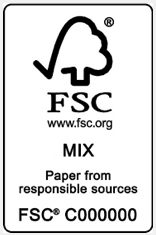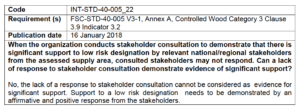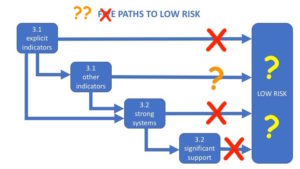 In our last post, we were pleased and excited to finally begin discussing the long-awaited details of the Forest Stewardship Council’s National Risk Assessment for the USA. The US-NRA is quite possibly the most significant new policy document produced by FSC’s US affiliate in years. It is important, still in need of work, and worth giving our attention to.
In our last post, we were pleased and excited to finally begin discussing the long-awaited details of the Forest Stewardship Council’s National Risk Assessment for the USA. The US-NRA is quite possibly the most significant new policy document produced by FSC’s US affiliate in years. It is important, still in need of work, and worth giving our attention to.
We hoped to continue and add to our writing about the US-NRA this week, but we find that we cannot. We will return to that subject soon. For now, we must address a more pressing concern. In December, we wrote yet another installment in the long, ugly story of Controlled Wood implementation. At the heart of this story is the “Category 3 Problem” for companies who rely on Company Risk Assessments (CRA’s). Our hope then was that the publication of the US-NRA would finally resolve all of these problems. Perhaps someday it might do that, but not yet.
Implementation Chaos – getting worse!
The confusing and frustrating challenge for Controlled Wood companies has been to understand, interpret, and follow the overlapping and sometimes conflicting guidance from FSC and the Certification Bodies (CBs), while still managing to run their business. Controlled Wood Category 3: High Conservation Values (HCVs) has proven the most troublesome. In our December post, we identified “5 Paths to Low Risk” in a chart that looks like this:
Charts like this one always simplify things more than they should. The truth is that, while 5 paths do exist and still are in use – some of them are probably unwise and do not follow common-sense reading of the FSC requirements. A more honest chart would have looked like this one:
This modified chart shows the two (maybe 3) paths that most successful practitioners (and clever consultants) have been employing over the last year or so. The first, and most common, path uses evidence for indicators 3.1 and 3.2, backed up by an independent stakeholder consultation process designed to demonstrate “significant support” for the program. This “significant support” is, in practice, demonstrated by lack of objection from a reasonably wide selection of “interested” parties. More on that later.
The second, and less common, approach employs a deeper analysis of evidence using a number of “other” sources to demonstrate low risk for the HCV indicators listed for clause 3.1, without citing the “strong systems of control” indicator in 3.2. We call this the “3.1 only” strategy. The “3.1 only” strategy has been questioned by a number of CB’s and opinions differ about its validity. That’s why we marked it with a “?” in our chart.
Disturbing the Consensus – one more time!
Last week, FSC-IC released a number of new, official Interpretations for their standards, including this one:
This latest guidance is still being processed and discussed in the community. MixedWood has been in touch with many of the leading specialists in this area, and most us are still puzzled and uncertain.
On its face the new Interpretation seems to change the rules for Stakeholder Consultation in CRAs. Up to this point, consultations have been pretty straightforward. A representative list is assembled. Notices are distributed. The company waits for a reasonable period of time and concludes that stakeholders are satisfied. Many thousands of contacts have been made, throughout the US, Canada, and many other countries. They have generated virtually no response and (to our knowledge) absolutely no objections. With this new guidance, FSC is invalidating all of this. The new expectation seems to be “an affirmative and positive response”. What does this mean? We do not know.
The effect of FSC’s new mandatory Interpretation may be to close off the remaining paths that a CW company in North America can use to conclude Low Risk for Category 3 of the Controlled Wood standard. In theory, this would require CW companies to design and implement a series of “Control Measures” designed to mitigate the apparent risk to the specified issue. Ironically, this is just what FSC-US has been trying to do for the last 5 years. They finally have a proposal before us that we ought to be discussing, debating, and analyzing right here in this space. But instead, we are tangled up with the same old problems.
In theory, INT-STD-40-005_22 invalidates every Controlled Wood claim in the entire North American marketplace. The invalidation of CW claims should lead to the invalidation of every FSC Mix claim. Does this mean that – as of 16 January 2018 – the FSC-certified market in North America is officially suspended? We don’t think so, but in all honesty, we are not certain.
What Happens Next?
 As far as we know, the sun will, indeed, rise tomorrow morning. Trees will grow. Loggers and foresters will go about their work. Wood will be shipped to the mills. Lumber and paper will be manufactured. Thousands of companies will produce their products and ship them to their customers. Millions and millions of FSC-certified commodity products, on store shelves around the world, will still be for sale. Life will go on.
As far as we know, the sun will, indeed, rise tomorrow morning. Trees will grow. Loggers and foresters will go about their work. Wood will be shipped to the mills. Lumber and paper will be manufactured. Thousands of companies will produce their products and ship them to their customers. Millions and millions of FSC-certified commodity products, on store shelves around the world, will still be for sale. Life will go on.
Soon, some of us (we hope that includes many of you) will participate in the job of getting our National Risk Assessments (NRAs) finalized, approved, and implemented for the US and Canada. With this task accomplished, much of this will get easier.
Our message to practitioners remains the same: please stay engaged and assertive. We can get through this.
Our message to our friends at FSC: please, please, PLEASE stop making it harder!
UPDATE (15 Jan 2018): This post has been updated to correct misleading links to the newly updated FSC Interpretations document for Controlled Wood. The version now found in the FSC Document Center is presently out of date. The new version (dated 16 Jan 2018, but distributed via email last week) that includes INT-40-005_22 can now be downloaded directly from our server.
UPDATE#2 (16 Jan 2018): The FSC Policy & Standards Unit (PSU) circulated an email update this morning with a new version of the Interpretations Document that we discussed above. The document includes 2 new Interpretations that were not included in last weeks version. One of these (INT-STD-40-005_26) is interesting and relevant to the topic of this article. Although it is numbered 26, they have confusingly inserted it between #22 and #23. You can find it on page 22. The new version is now available – as it should be – on the regular FSC Document Centre website.
UPDATE#3: We were right. The sun did come up this morning. Hopefully it will again tomorrow.


